Volkswagen’s highly anticipated ID.Buzz electric van gets it right. Mostly.
A couple weeks ago I was able to spend much of the day with production-spec versions of the 2024 VW ID.Buzz and found it to be a refreshing departure from the compact-to-mid-size crossover forms that have become banal.
It’s neither an outfit-ready electric vanning rig nor the family-van equivalent to Rivian’s R1 trucks. But in America, the way it’s likely to be packaged, it has a good chance for becoming a great family vehicle in the tradition of a minivan.
There’s a lot riding on it. But on the flip side, there’s really nothing like it. And to get to the mic-drop moment from the start, for us in the U.S., it’s still two years away.
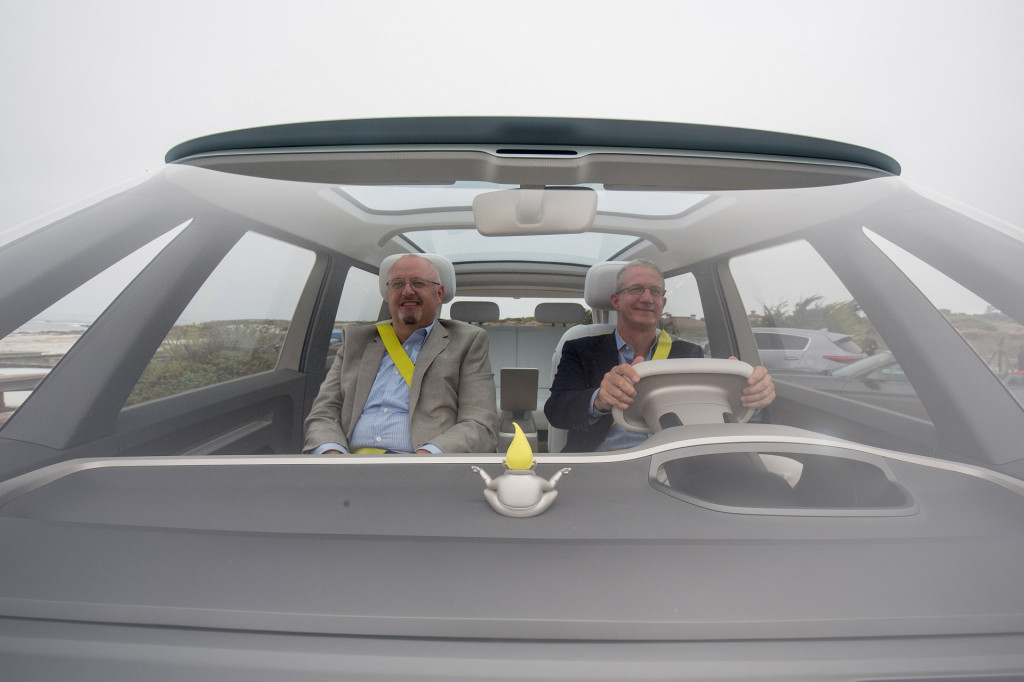
Kirk Bell and John Voelcker in Volkswagen ID Buzz electric Microbus concept vehicle
Yes, it’s been more than 20 years since VW started teasing the Microbus reboot in concepts, and that vision has been an electric one since 2011. VW said that it would build the ID.Buzz concept it revealed in January 2017 and let us drive a prototype ID.Buzz (photo above) in August 2017, and while it’s taken five long years to bring this model to production, it’s going to be another two to produce the long-wheelbase, three-row version bound for the States.
2024 VW ID.Buzz: So far so good. Very good.
All this said, VW didn’t mess any of this up yet, and the ID.Buzz is an appealing product—one that really should be coming to the U.S. now in its standard-wheelbase form.
At present, the ID.Buzz is 185.5 inches long—so its overall length just fits into what in the U.S. might actually be considered a compact crossover, as vehicle size gradually creeps upward. Wheelbase is 117.7 inches for current ID.Buzz models, while they’re 78.1 inches wide and about 77 inches tall overall, varying slightly depending on the spec.
The future U.S. version will be 10.6 inches longer in wheelbase—128.3 inches axle-to-axle—which would bring its overall length to about 196 inches (think Tesla Model X).
In its current form, the turning circle is a neat 36.4 feet, and the ID.Buzz handled neatly in Copenhagen’s crowded bikes-first environment where we started. From the driver’s seat, the split A-pillar and front quarter window afford a good view outward, although you look over the corner of the dash and are left guessing as to the exact placement of the front corners for parking.

Volkswagen ID.Buzz (Euro spec)
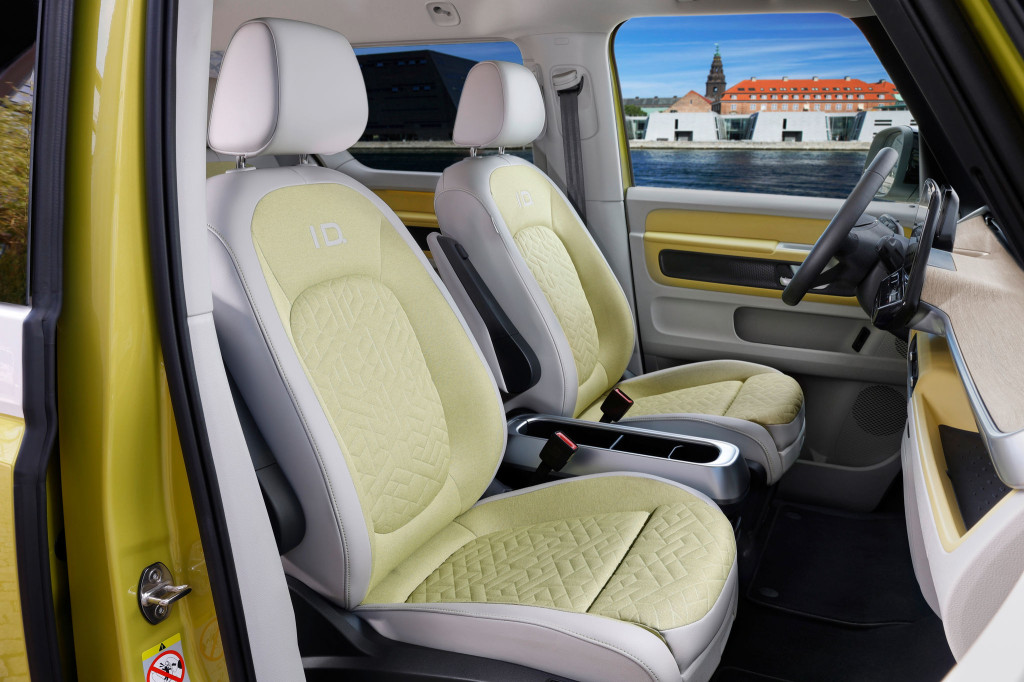
Volkswagen ID.Buzz (Euro spec)
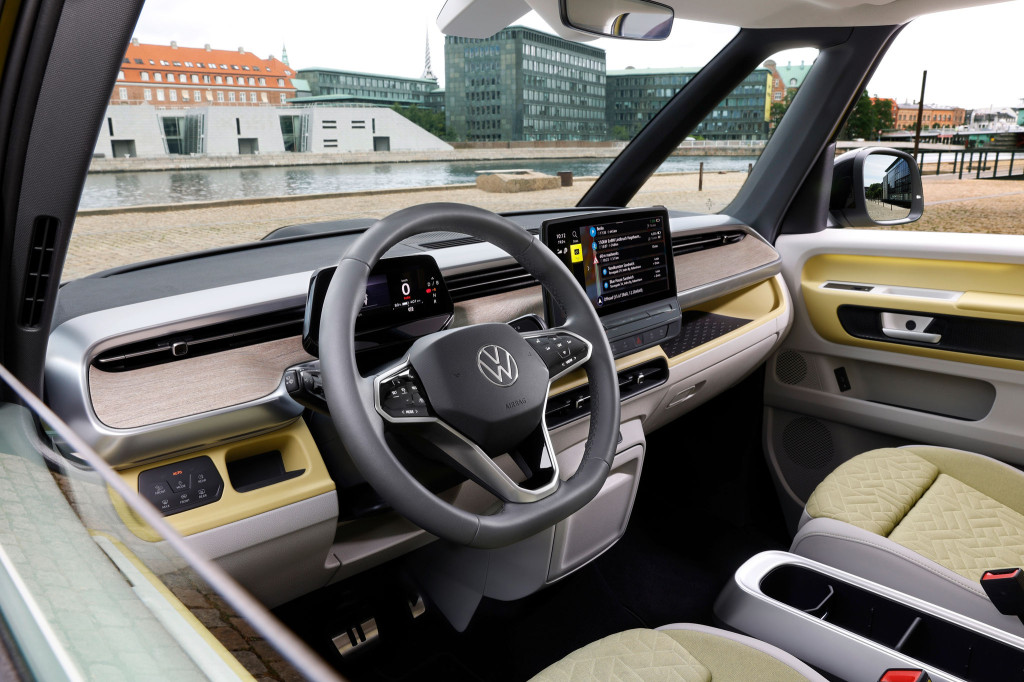
Volkswagen ID.Buzz (Euro spec)
For as small as its footprint is, the ID.Buzz is heavy. In well-equipped ID.Buzz Pro form, as we drove it, the ID.Buzz weighs about 5,400 lb—or 600 lb more than the single-motor ID.4.
Like the original VW Bus, the Buzz borrows from a smaller car and keeps it relatively simple, carrying over most of its underpinnings and propulsion pieces from the ID.4—potentially helping to realize the mass-production potential of VW’s MEB electric vehicle platform.
U.S. version likely bigger, heavier, quicker
The ID.Buzz has the same 82-kwh (77 kwh usable) battery pack as the ID.4. It’s yet unclear whether the U.S. ID.Buzz will include a bigger battery pack, afforded by the longer wheelbase. At 14 modules rather than 12 modules, the U.S. version might pack 96 kwh, with about 90 kwh usable—bringing range closer to 300 miles, despite a curb weight close to 6,000 lb. For the meantime, that’s all speculation.
At present, the entire ID.Buzz lineup is powered by a single permanent-magnet electric motor at the rear wheels, delivering 201 hp and 228 lb-ft of torque. VW says that the Buzz will get to 62 mph in about 10 seconds. The ID.Buzz, like the ID.4, rides on front struts and a rear multi-link suspension, with front disc brakes but rear drum brakes that VW terms “wear resistant”—making it quite possibly the heaviest and most expensive modern passenger vehicle with them.
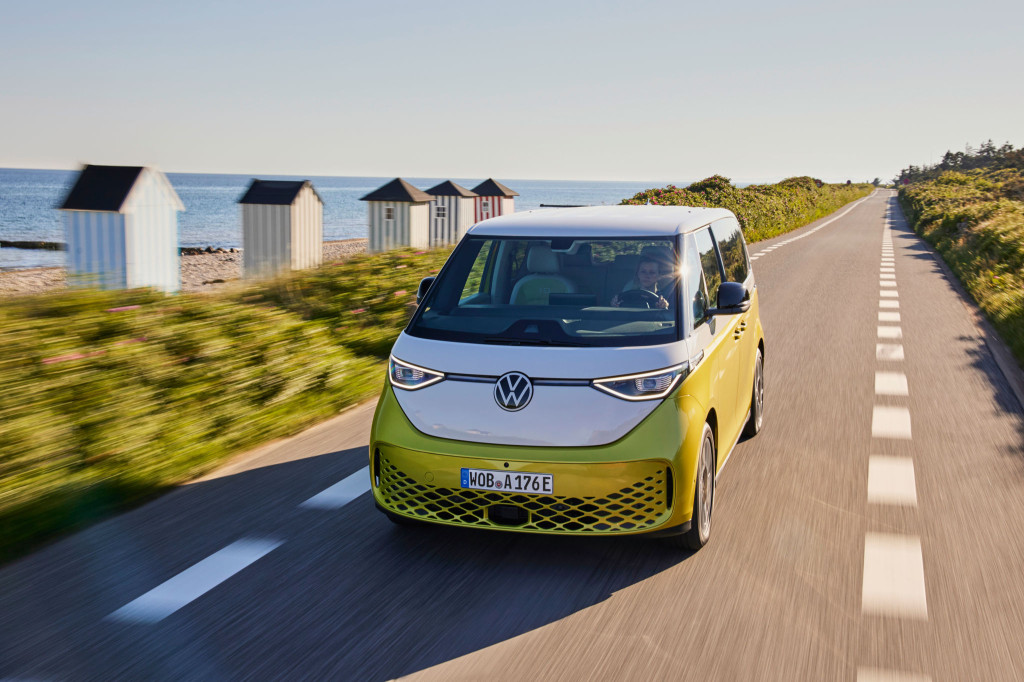
Volkswagen ID.Buzz (Euro spec)
The leisurely acceleration is by no means a buzzkill. To insert some reality here, that’s faster even than the Vanagon when the VR6 arrived, and ridiculously quick next to any air-cooled Bus. But admittedly, it doesn’t have the stealth performance factor that many of the latest EV crossovers do.
All-wheel drive is in the cards
All-wheel drive is a future feature that VW doesn’t say outright is coming. But I spun the question to a technical expert, asking whether a dual-motor version could easily be added, and they replied that the entire front axle area is carried over from the ID.4 and they haven’t put anything where the motor goes. So count that as a pretty strong hint; in the ID.4, the dual-motor setup adds up to 295 hp and 339 lb-ft of torque.
What the ID.Buzz does have is a comfortable ride, a super-quiet cabin, and more poise than it initially lets on. Pitch it hard into a roundabout and there’s lots of lean; push it a little harder and it makes clear that the low-set battery pack makes it very stable and grippy.
The ID.Buzz, as the ID.4 offers two different levels of regenerative braking. If you select ‘D’ with the twist shifter just to the right of the steering wheel, the ID.4 will scrub off speed about like a gasoline vehicle—except if you’re following closely behind someone. Shift to ‘B’ and the ID.Buzz decelerates far more eagerly, pulling up to 0.3 g and sending up to 100 kw to the battery. As with the ID.4, VW suggests that ‘B’ might not be the most efficient way to get around.
Efficient for a box on wheels
According to VW the ID.Buzz goes 423 km on a charge. On that European WLTP cycle, the ID.4 goes up to 517 km, so if the Buzz follows suit, something less than 250 miles might be its top end from this battery pack.
Efficiency appears to be quite close to what we’ve seen in the ID.4, though. Over one 89-mile stint that involved a mix of mostly calm driving in the city and along the coast, some freeway driving up to about 80 mph briefly, and a few blasts of foot-to-the floor acceleration—with two aboard—our trip computer claimed an average of 3.1 miles per kwh. That’s enough for more than 230 miles; credit its great 0.285 coefficient of drag.
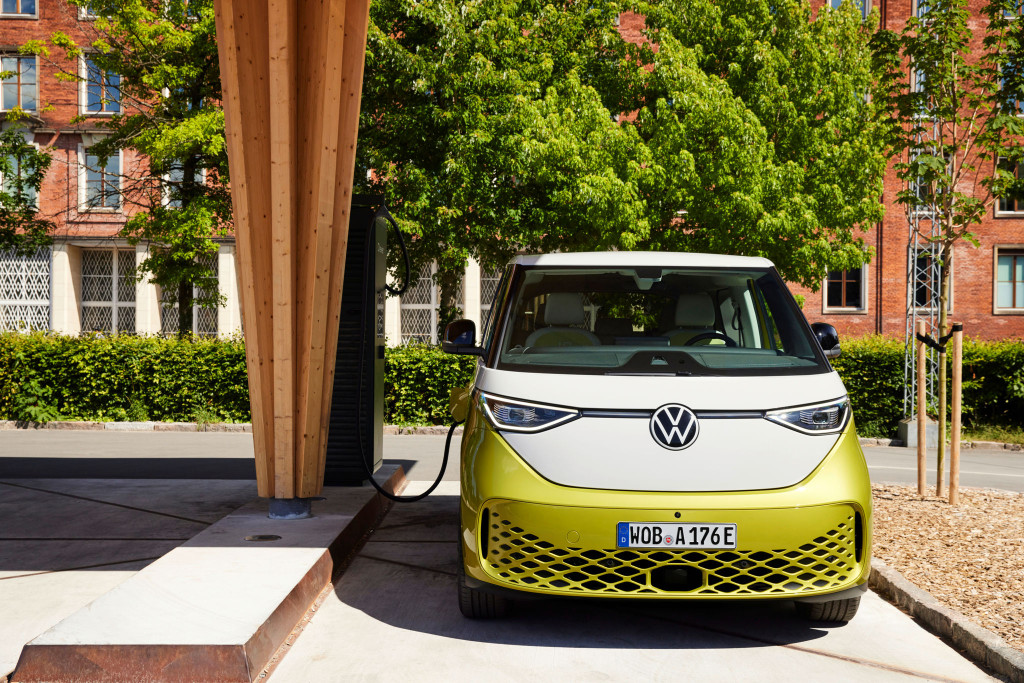
Volkswagen ID.Buzz (Euro spec)
The ID.Buzz takes advantage of stepped-up 170-kw peak DC fast-charging power that allows a 5% to 80% charge in 30 minutes. In Europe, VW also offers the ID.Charger Travel, which it describes as “a kind of mobile wall box,” allowing its peak 11 kw even when on trips.
Function follows form
Wherever we went in our Energetic Orange ID.Buzz (two-tone, with Candy White), we were met with the sorts of head-turning reactions you might find only for supercars. Typically very conservative Swedes and Danes were waving, head-turning, and flagging us down—all extremely atypical.
We started the day in colorful Copenhagen, maneuvering past those swarms of bicyclists and the city’s enchanting mix of canals and centuries-old buildings interfaced with modern architecture.
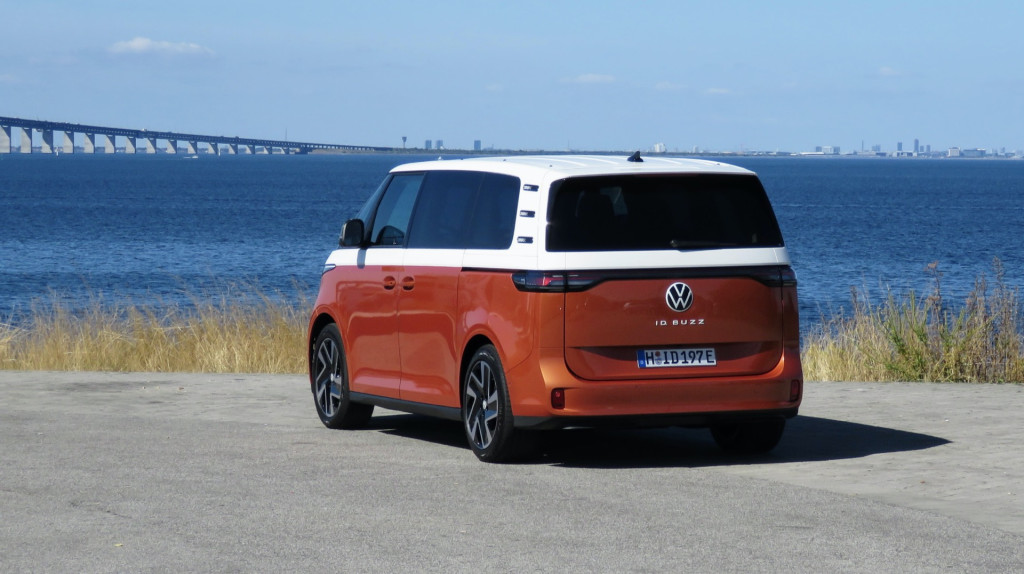
Volkswagen ID.Buzz (Euro spec)
From there, we headed over the five-mile-long Øresund Bridge to Sweden and down to the beach town of Falsterbo.
There, a man with Koenigsegg connections asked some questions, then another strolled over and hovered around us while we snapped a few pictures of the Buzz. As we paused, I noticed he was wearing a VW van T-shirt and pulled out his phone to show galleries of his ’65 split-window for sale—a vehicle that’s today worth something close to the $70,000 or so that I would estimate most of the new vans selling for by the time they arrive in two years.
Keeps the retro on the outside
For the most part, VW appears to have learned from the New Beetle and the ID.Buzz leaves its retro cues on the outside. The production Buzz on the inside just feels like a well-designed, quiet, modern, comfortable-riding family vehicle on the inside. One that happens to invite rubberneckers wherever you drive and questions wherever you park.
Outside of the shock and awe of the design, there are few points of above-and-beyond interface points here. Door handles are conventional. There’s no gimmicky charge-port door; it’s on the right side, just behind the sliding side door when it’s all the way open. And instead of a frunk there’s essentially a small access panel good for washer fluid and a few other service points. By the time the Buzz makes it to the U.S., sources say that it will have a large, panoramic-style glass roof, as was used in the concept.

Volkswagen ID.Buzz (Euro spec) – infotainment running software version 3.2
Just as the ID.4, the ID.Buzz has a 5.3-inch gauge display just ahead of the driver, plus a 10.0-inch or 12.0-inch touchscreen at the middle of the dash. With up to eight USB ports, rated for up to 45 watts, there are plenty of places to charge phones, tablets, and even laptops, along with trays for those smaller devices.
Our Buzz is running VW’s software version 3.2, which U.S. buyers will be seeing in 2023 ID.4 models starting soon—and hopefully soon, too, applied over-the-air to existing models spanning back. From the steering-wheel haptic buttons to the touchscreen, and ID.Light, which signals things like navigation prompts with streaks of color-coded light, this is now a sharp, quick interface and we didn’t notice a single bit of the laggy, glitchy behavior that gave us pause in early ID.4 models. It goes to show, given the same hardware, how much of interface behavior comes down to software.
If anything, the only packaging faux pas is that there is no clever folding to free up the second-row space as cargo space. It’s no stretch to imagine the second row flipping up vertically after it folds, for example, or releasing entirely, minivan-like, to be stowed away. That can all be remedied down the line with solutions from the minivan playbook—perhaps as part of the three-row layout.
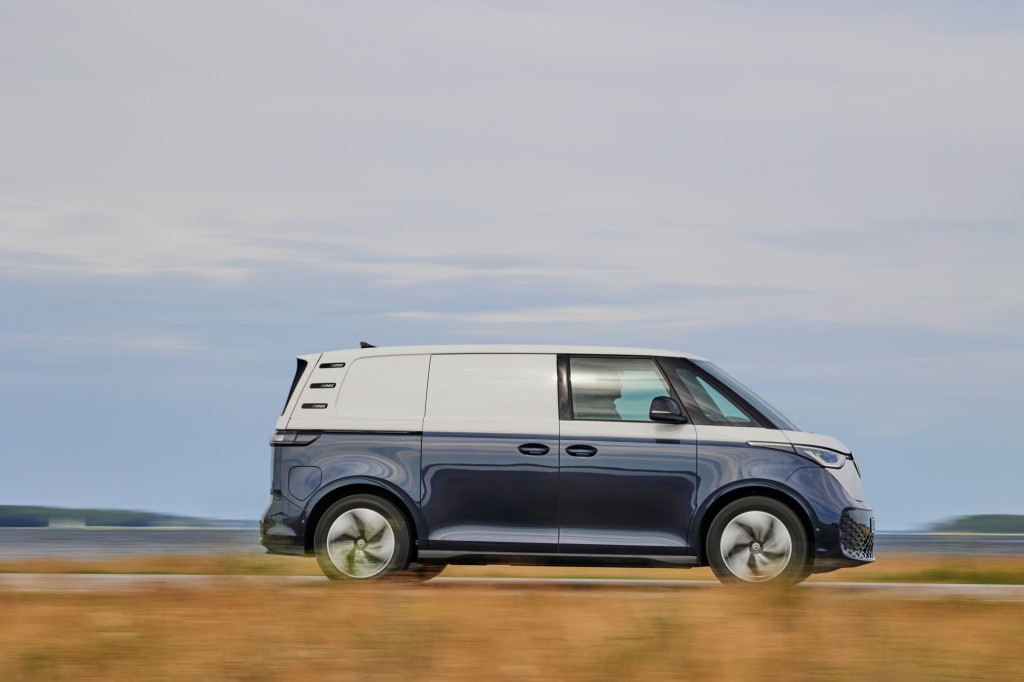
Volkswagen ID.Buzz Cargo (Euro spec)
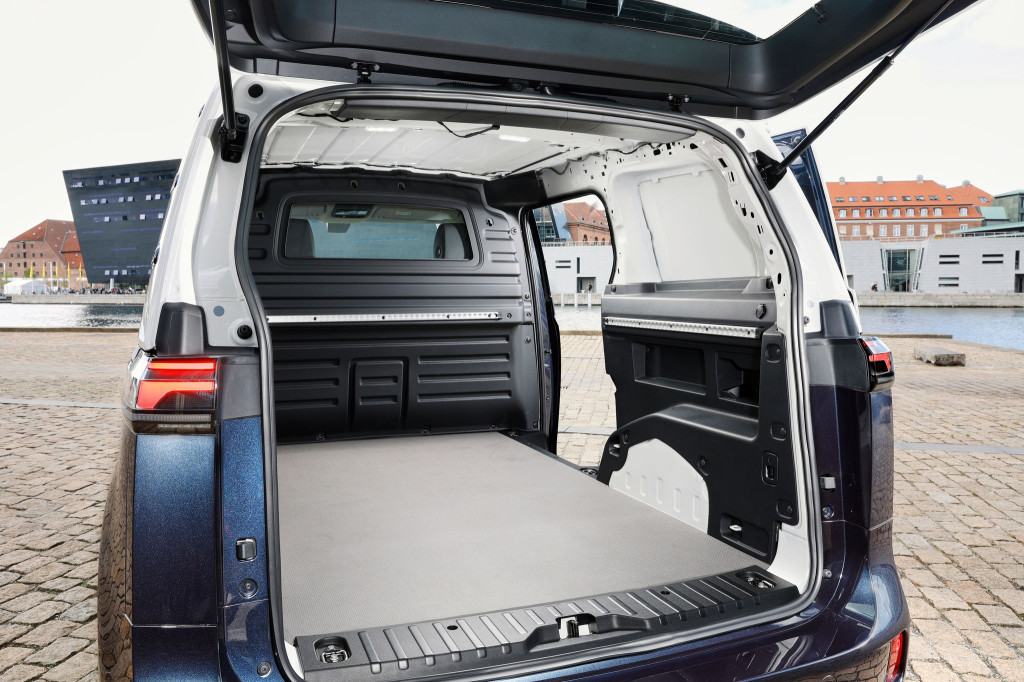
Volkswagen ID.Buzz Cargo (Euro spec)
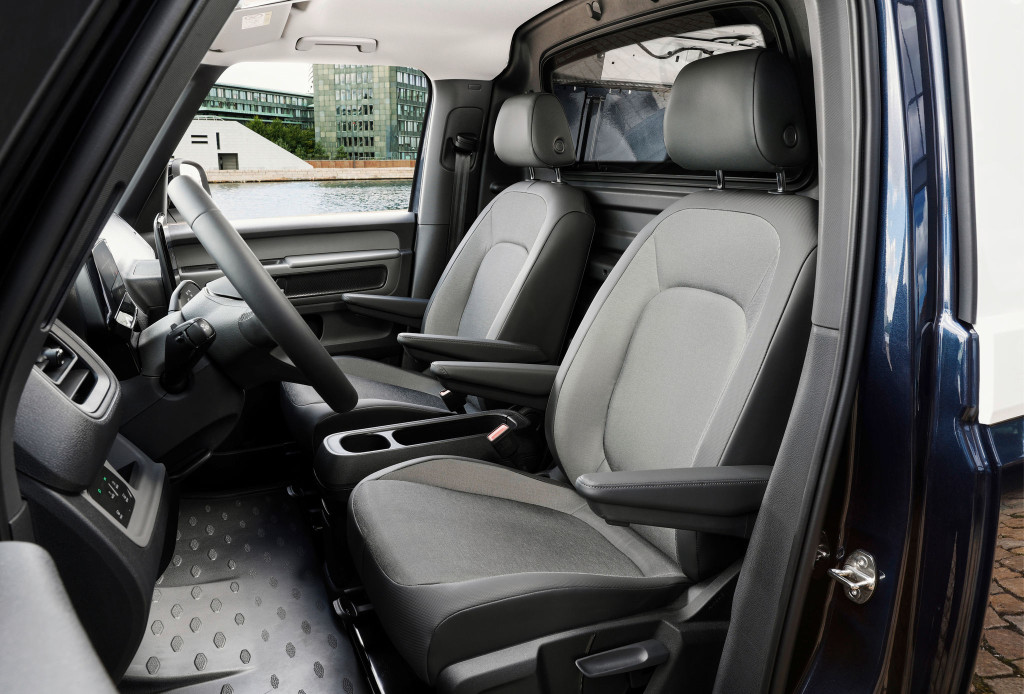
Volkswagen ID.Buzz Cargo (Euro spec)
An ID.Buzz Cargo does exist, providing that box of stuff-carrying potential some might be waiting for. A short trip in the Cargo hinted at what we might one day encounter in a base-model U.S. passenger Buzz, if it’s ever produced—things like manual-adjusting seats and a simpler, more monochromatic theme to the interior trim. I was surprised, though, to find that the Cargo nearly met the same standards of NVH as the passenger version.
Both the ID.Buzz and ID.Buzz Cargo are being made in Hanover, Germany, and development of the vans was headed up by VW Commercial.
There are some confusing messages here. The ID.Buzz was conceived and developed with the help of VW Commercial, and while it welcomes work with upfitters for various purposes, it’s not yet providing them access to energy from the traction battery. The ID.Buzz is ready for bidirectional charging (V2H), VW says, with a home energy system, but if you look at Rivian’s camp kitchen package it’s quite the untapped potential.
Why wouldn’t this revive the American family van?
Further, VW does not expect it to be a very high-sales-volume vehicle. I think they’re wrong—especially in the U.S.
In much the same way the Volkswagen vans were a counterpoint—and counterculture touchpoint—to the gas-guzzling, increasingly complex V-8 muscle cars of the time, the ID.Buzz stands as an alternate path forward for electric vehicles, and cult favorite for families who don’t want a same-as rugged crossover.

Volkswagen ID.Buzz (Euro spec)
What’s not entirely in agreement with this is the price. There’s been no official statement about U.S. pricing, but if we take our nods and winks at face value, look for the ID.Buzz to start around $55,000 officially but with early builds and probably most of them selling around $70,000. Should VW decide to assemble this model in Chattanooga, given the level of carryover from the ID.4 and VW’s plans for U.S. sourcing of that model, it would fall under the $80,000 price cap for vans and could be eligible for the EV tax credit.
So in two years will we get a top-money halo vehicle, or will we get a new kind of affordable electric family wagon? Really, it’s not an either/or.
—
VW flew us to Copenhagen to bring you this test drive review.
